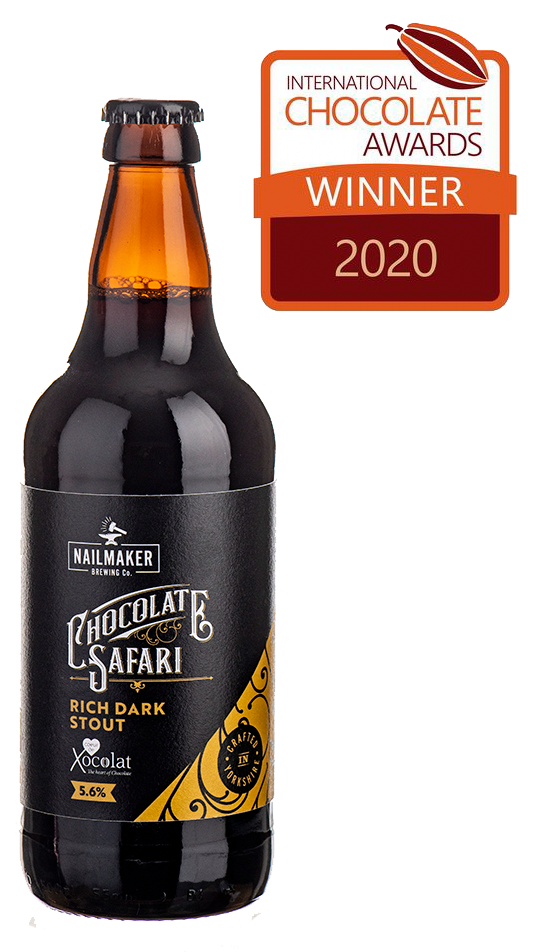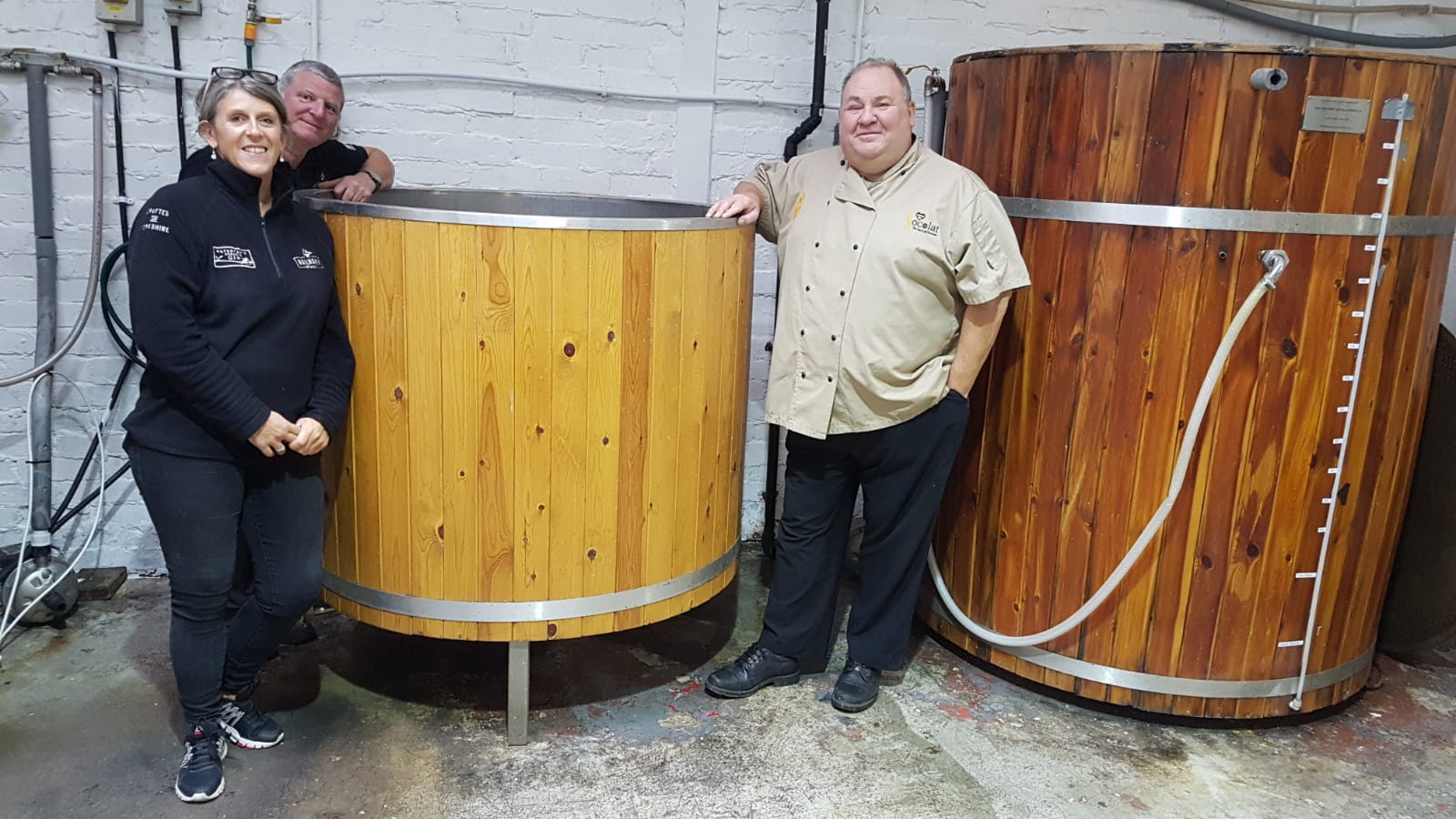
Nobody can can deny the mood-altering ability that chocolate gives us, butwe shouldnt forget that it has more history as a drink than as a confectionery snack.
If we look back to Mesoamerican history, chocolate was a gift from the gods, and used as an offering back to the gods and was reserved only for royalty and the military and ruling. This is similar to the role that beer played throughout Europe during the Middle Ages.
It's true that beer and chocolate are in different camps, but they do have complementary flavours and they are both the product of fermentation.
Beer is flavoured with three things: grain, hops and yeast and when heated malted grain can have notes of honey bread caramel toffee raisin and many others.
Fine chocolate has up to 1500 aromas some of which are described as grassy, floral, yeast, nuts, caramel, woody, spicy and fruity, so it shouldn’t be so surprising that they pair well together.
Chocolate begins with the cacao tree, which grows in the tropics of (for example São Tomé), the beans of this small tree are fermented, roasted, husked and ground into cocoa nibs.
The nibs are then pressed to separate the natural fat, (cocoa butter) and cocoa mass.
Beer is an alcoholic beverage made by the fermentation of grain and, for the vast majority of the world’s beers, the grain base is barley.
The brewing process starts with malted barley, or ‘malt’, which is then milled. Next, the brewer steeps it in hot water to extract their flavours; the malt is heated with water in a large kettle called a ‘mash tun’. At the end of mashing, the starches in the malt have been broken down into simple sugars, resulting in a sweet liquid ‘wort’.
The malt is rinsed (‘sparging’) and strained to get the last of the sugars into solution. The used malt is now considered to be ‘spent grain’, but still great for baking. The wort is then piped into the next large tank, the brew kettle. Here, hops are added and boiled with the liquid, providing bitterness and aroma. After boiling, the wort is quickly cooled 24C to add yeast. The yeast is pitched in to the sweet wort, where it feeds on the sugar, releasing alcohol and carbon dioxide.
After a while, the food runs low, and the increasingly alcoholic atmosphere becomes unfriendly: the yeast slows down. Fermentation is complete. The young beer is transferred to conditioning tanks to age, a process that can go from a few days to several weeks (or, occasionally, years) depending on the style.
Not surprisingly, adventurous chocolatiers and brewers are finding ways to include cocoa in some of their more inspired recipes.
There are a couple of things we need to be aware of when using cocoa in brewing:
One, cocoa is bold not shy, so be careful.
Two, not all ales are man enough to cope with the intense flavours that cocoa brings.
Balance! ease off on the dark malts at the same rate at which you add the cocoa and the results should be good.
Cocoa Basics
Cocoa can be added to beer in four ways:
Chocolate syrup, Cocoa powder, Chocolate bars
 Cocoa nibs.
Cocoa nibs.
All four are relatively trouble-free and can be used at different stages of the brewing process.
The chocolate bars that are available in the shops don’t always work well with beer, it usually has too much sugar, oils and other additives and the brewer needs to decide what and how much of any ingredients go into our stout.
So here we are using organic, fer mented, dried cocoa nibs from Sao Tome & Príncipe.
Nibs are essentially cocoa beans that have been roasted (for hygiene and flavour).
Taste and smell them before using and trust your instincts, aroma is always the brewer’s and the chef’s best tool.
Lightly roasted nibs work well in a brown ale or porter, but the fuller roasted nibs more at home in an imperial stout.
Nib are about the same size of a barleycorn so can be used directly in the mash, the boil, or suspended in conditioning beer like hops or spices like you would coffee beans – roasted, crushed like a specialty grain, and added in small amounts as a steeping grain or in the mash.
We are also going to be using chocolate
malt. (Chocolate malt is malted barley, kilned to a dark brown colour).
It gives the beer a chocolate-like aroma and taste, many brewers use the word chocolate in the names of their beers, but only a few of us actually use real cocoa nibs.
I find that the flavour is fully extracted in the mash, adding another roasted dimension to the brew.
If used in conditioning beer, simply fill a small mesh sachet with nibs and suspend in the beer with a string. Since the extraction will be lower and mellower than if it is mashed or boiled, you will find that this approach will give a softer edge to the finished beer.
There are many great recipes online for stout and porters have fun experimenting.
Here’s a recipe for a Chocolate Porter that will allow brewers to experience the wonderful fusion of chocolate and beer.
This recipe makes a robust, full-bodied porter with rich chocolate notes, perfect for cold evenings.
Recipe Title: Chocolate Porter
Description: A dark, rich porter with layers of roasted malt and bittersweet chocolate.
Cocoa nibs from São Tomé add a bold, authentic chocolate flavour, while chocolate malt brings an extra roasted dimension.
Style: Porter
ABV: 5.5%
IBU: 30
Batch Size: 20 litres
Ingredients:
Malted Barley:
4.5 kg Pale Malt
250 g Chocolate Malt
250 g Caramel/Crystal Malt (60L)
100 g Black Malt
Hops:
30 g East Kent Goldings (bittering)
20 g Fuggles (flavouring)
Yeast:
1 sachet of English Ale yeast (e.g., Wyeast 1968 London ESB)
Adjuncts:
200 g Cocoa Nibs (lightly roasted)
250 g Lactose (optional, for a creamier mouthfeel)
Instructions:
1. Mash the Grains:
Heat 15 litres of water in your mash tun to 68°C. Add the pale malt, chocolate malt, caramel malt, and black malt to the water and stir to ensure there are no clumps. Maintain the temperature at around 65°C for 60 minutes to allow for the extraction of sugars. This mash temperature helps balance body and sweetness.
2. Sparge and Collect Wort:
After the mash is complete, sparge the grains with hot water (at around 75°C) to collect 25 litres of wort. This process rinses out the remaining sugars from the malt.
3. Boil the Wort:
Bring the wort to a rolling boil. Add the East Kent Goldings hops at the start of the 60-minute boil for bitterness. Add the Fuggles hops in the last 15 minutes for flavour. If you’re using lactose, add it with 10 minutes left in the boil.
4. Add Cocoa Nibs:
When there are 10 minutes left in the boil, lightly roast the cocoa nibs and crush them with a rolling pin. Add them to the boiling wort. This allows the chocolate flavours to integrate with the beer without becoming overpowering.
5. Cool the Wort:
After the boil, quickly cool the wort to around 24°C using a wort chiller or an ice bath. This is crucial to prevent contamination before fermentation.
6. Fermentation:
Transfer the cooled wort to a fermenter and pitch the yeast. Seal the fermenter with an airlock. Let the beer ferment for around 10-14 days at 18-20°C until the specific gravity stabilises, indicating fermentation is complete.
7. Conditioning with Cocoa Nibs (Optional):
If you want a more pronounced chocolate flavour, after primary fermentation, transfer the beer to a secondary fermenter and add an additional 100 g of cocoa nibs. Suspend them in a mesh sachet to infuse for 5-7 days.
8. Bottling:
Once fermentation is complete, bottle the beer with 100 g of priming sugar to carbonate, or keg it if preferred.
Allow the beer to condition in bottles for 2-3 weeks at room temperature before tasting.
Brewer’s Tip:
For a richer chocolate profile, experiment with different roast levels of cocoa nibs. Lighter roasts add fruity and nutty notes, while darker roasts give a deep, bittersweet chocolate intensity.
Fun Fact:
Chocolate has been enjoyed as a drink for thousands of years, but it wasn't until the mid-19th century that it was transformed into the solid chocolate bars we enjoy today.
This recipe provides a great balance of roasted malt flavours and cocoa's complex aromas.
You can adjust the cocoa nibs and malt to suit your preference, allowing for plenty of experimentation. It’s a wonderful fusion of craft brewing and fine chocolate!
